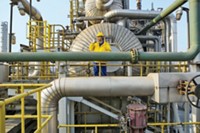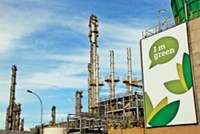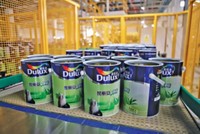Advertisement
Grab your lab coat. Let's get started
Welcome!
Welcome!
Create an account below to get 6 C&EN articles per month, receive newsletters and more - all free.
It seems this is your first time logging in online. Please enter the following information to continue.
As an ACS member you automatically get access to this site. All we need is few more details to create your reading experience.
Not you? Sign in with a different account.
Not you? Sign in with a different account.
ERROR 1
ERROR 1
ERROR 2
ERROR 2
ERROR 2
ERROR 2
ERROR 2
Password and Confirm password must match.
If you have an ACS member number, please enter it here so we can link this account to your membership. (optional)
ERROR 2
ACS values your privacy. By submitting your information, you are gaining access to C&EN and subscribing to our weekly newsletter. We use the information you provide to make your reading experience better, and we will never sell your data to third party members.
Business
Keeping The Faith At Germany’s BASF
Chairman Kurt Bock seeks to balance old and new at the world’s largest chemical maker
by Michael McCoy
June 27, 2011
| A version of this story appeared in
Volume 89, Issue 26

In April, Kurt Bock packed a suitcase at his family’s New York City apartment and gathered some belongings in a suburban New Jersey office park. Bock was about to take over as chairman of BASF, the world’s largest chemical company, and he was moving back to headquarters.
Headquarters for BASF is Ludwigshafen, Germany, where the company runs the world’s largest chemical manufacturing site, a massive complex that occupies 10 km2 on the Rhine River. There, at the spot where BASF built its first facility in 1865, 33,000 employees work in research, manufacturing, and business operations.
It’s a breathtaking complex that reminds Bock of all the facets of the sophisticated business he leads. “You’re not sitting in some lofty office in midtown Manhattan looking into the sky,” he says. “You see chemical operations. You meet people from all over the site with very different backgrounds and very different experiences. It keeps your feet on the ground.”
Although Ludwigshafen is, as Bock says, “the heart of BASF,” it does not dominate the company as it once did. After several major acquisitions over the past five years, BASF today has 109,000 employees, only 30% of whom work at the headquarters site.
The company Bock now leads is truly global, with almost 400 production sites around the world and subsidiaries in more than 80 countries. BASF owes its early survival and later success to a philosophy of manufacturing integration it calls Verbund, which originated in Ludwigshafen and has been replicated at five other company locations. The challenge for Bock will be to keep the spirit of Verbund alive at today’s sprawling, multifaceted BASF.
Bock insists he’s up to the task. Born in 1958 in the small town of Rahden, Germany, he pursued business administration at university and then a Ph.D. in economics. He found his studies too “ivory tower,” though, and decided he wanted to enter manufacturing with a global organization. After interviews at numerous companies, he was most impressed by BASF and joined the firm in 1985.
Bock left BASF in 1992 for a more senior position at the German industrial company Bosch, but he returned in 1998, lured home by Eggert Voscherau, an influential BASF executive who at the time was responsible for the firm’s operations in the Americas.
BASF At A Glance
Headquarters: Ludwigshafen, Germany
Sales: $84.7 billion
Net income: $6.0 billion
R&D spending: $2.0 billion
Capital spending: $3.4 billion
Employees: 109,000
BUSINESSES (% of total sales):
Performance Products (19%): Dispersions and pigments, care chemicals, paper chemicals, nutrition and health products
Chemicals (18%): Petrochemicals, inorganics, intermediates
Oil & Gas (17%): Exploration and production of oil and natural gas
Plastics (16%): Engineering polymers, specialty plastics, polyurethanes
Functional Solutions (15%): Catalysts, construction chemicals, coatings
Agricultural Solutions (6%): Fungicides, herbicides, insecticides
Other (9%): Styrenic plastics and fertilizers
NOTE: Figures are for 2010. Currency converted at average 2010 exchange rate of $1.00 U.S. = 0.7541 euros.
By 2003, Bock had been named BASF’s chief financial officer. In this role, he was involved in the company’s three big acquisitions—the multi-billion-dollar purchases of Engelhard, Ciba, and Cognis—as well as in smaller purchases such as Johnson Polymer and Degussa’s construction chemicals business. In 2007, he took on the additional responsibility of leading BASF Corp. in the U.S. He was named future chairman of BASF’s board of executive directors, the German equivalent of chief executive officer, in May 2010, and he replaced Jürgen Hambrecht in that role at the end of the firm’s annual meeting on May 6, 2011.
Hambrecht was known for his dynamism and drive, and Bock has a reputation for being reserved, even a little dour, in contrast. But in an interview with C&EN, he is engaging and enthusiastic. Asked whether BASF has become too big or too complex, Bock responds in mock anger. “Is it too big? No, it is not too big!” he exclaims.
Bock acknowledges that his style differs from Hambrecht’s. But Hambrecht differed from Jürgen Strube, the lawyer who preceded Hambrecht as chairman. “I think it is a strength of the company that you can have different types of people and still have the same values and the same basic ideas about what is good for BASF,” Bock says. “There are different ways you can achieve your objective.”
And Bock points out that he is just one of eight members of the executive board that runs BASF and sets its long-term objectives. “I am the chairman, but decisions are taken together,” he says.
Geoff Haire, a veteran stock analyst who covers BASF for HSBC Global Research in London, doesn’t expect Bock to significantly change the corporate direction that Hambrecht established. “That was one of moving the business toward the lighter end of the industry in terms of capital intensity and focusing very much on businesses where BASF had a very strong market share or a technical edge,” he says.
Haire has watched this shift over the past 10 years and seen BASF improve its profitability and returns. In the recession year of 2009, BASF was the rare chemical maker to earn a premium on its cost of capital, Haire notes. Nevertheless, he says, the company’s stock remains undervalued compared with European peers such as AkzoNobel, Arkema, DSM, and Lanxess.
Its huge range of businesses—BASF is active in every chemical sector except industrial gases—is a big part of the reason. “A lot of my clients say the company is very complicated and therefore apply a conglomerate discount to their valuation,” Haire says.
BASF is complex, Bock acknowledges. Its businesses range from the most basic of chemicals—ethylene and propylene—to complex biotech research and specialized ingredients for cosmetics and pharmaceuticals. BASF also operates a large, mainly European, oil and gas business.
“The question,” Bock says, “is how you manage complexity. I think we have a good hand for that. We are quite successful at keeping things simple despite their underlying complexity.”
BASF’s complexity stems largely from its size. In 2006, after a few years of jockeying, it surpassed Dow Chemical once and for all to become the world’s largest chemical company. The German firm’s subsequent acquisitions have only lengthened its size lead over its rivals.
Size means scale, Bock points out, and that’s important in the chemical industry. Ciba, which BASF acquired in 2009, had problems, he says, one of which was a suboptimal production footprint that forced it to move intermediates around the globe to complete the manufacturing of some of its products.
Since the acquisition, Bock says, BASF has closed a number of former Ciba facilities and integrated chemical production into existing BASF sites, including Ludwigshafen. “That automatically generates huge synergies,” he notes. BASF also has reduced the size of the former Ciba staff by about 30%.
Integrating Cognis, acquired late last year, will be a different challenge, Bock concedes, because manufacturing and distributing were only part of what it did. The secret to Cognis’ success was its ability to help customers in the nutrition, cosmetics, and home care industries develop unique personalities for their consumer products.

“The former Cognis had a very successful model for how to interact with customers, how to market its products, how to position itself—and we will keep that strength,” Bock says. “At the same time, we will integrate it completely.”
In March, BASF announced that it will close many of Cognis’ nonmanufacturing locations, paring 450 jobs in the process. It will keep almost all of Cognis’ manufacturing sites but tie them more closely with BASF’s, Bock says. For instance, Cognis must buy the ethylene oxide needed to create many of its cosmetic and home care ingredients. BASF, in contrast, is a major manufacturer of this basic chemical.
Such raw material integration is classic Verbund. Still, Bock acknowledges that other aspects of Cognis—its business in high-end botanical extracts for cosmetics is one example—don’t fit as neatly into Verbund. “BASF invented the concept and refined it to a high degree,” he says. “But at the same time, we have acquired more downstream-oriented businesses. I think the combination of a strong Verbund foundation and then reaching out and building downstream businesses works very nicely.”
A similar stretching of the Verbund concept is happening in R&D. Ludwigshafen is home to the chemical industry’s largest research center, and more than half of the 9,600 BASF employees involved in R&D work there. But the acquisitions of Cognis, Ciba, and Engelhard added important research centers in places such as Iselin, N.J.; Tarrytown, N.Y.; and Basel, Switzerland.“The relative importance of Ludwigshafen has come down a little bit; however, Ludwigshafen is still a huge research hub and cluster. We perceive it as a big advantage,” Bock says. “In many areas of chemistry, you probably have the highest density of knowledge and expertise in Ludwigshafen.”
Although Bock likes how BASF has used acquisitions to expand beyond its Verbund core, he says the firm’s focus for now will be on Cognis. “We really bring it into the tent,” he says of BASF’s approach to integrating new businesses. “When we make an acquisition, our intention is that we manage the acquired assets better than the previous owner and create additional synergies—otherwise we shouldn’t acquire them.”
Rumors have surfaced that BASF is considering a bid for Monsanto to significantly expand its presence in crop science. HSBC’s Haire considers such a deal unlikely. “They are very concerned about culture and cultural fit,” he points out. “If you buy a business like Monsanto, would it fit culturally? It’s a criterion beyond the financial.” Moreover, he says, BASF already enjoys some benefits of Monsanto’s seed business through an existing joint venture with the U.S. company.
Nonetheless, BASF has a sales goal for 2020 of ¤90 billion—about $130 billion, or 40% more than it logs today. One way it intends to get there is with business growth that is more than two percentage points above the overall market. Another way, Bock says, is more acquisitions.
He’s coy about identifying future target companies or markets. Asked whether there are portfolio holes he would like to fill, Bock smiles and responds simply, “Yes, there are.” Elaborating slightly, he says BASF seeks businesses with growth and profitability that are based on technical innovation, not the vagaries of supply-and-demand economics.
BASF’s major purchases to date have been of Western companies, but it isn’t for lack of looking elsewhere. “We’d love to acquire in Asia,” Bock says. “We’ve been studying this for years, but at the end of the day, in Asia, the availability of people willing to sell is limited.” Often, he adds, the companies that are for sale would require large investments to bring them up to BASF’s environmental health and safety standards.
In the meantime, BASF is putting its own feet on the ground in Asia, especially China. It has operated a Verbund-style petrochemical complex in Nanjing since 2005 and just won approval to build a major isocyanates plant in Chongqing. The company is expanding its acrylics complex in Malaysia and recently signed an agreement to build a $1.3 billion specialty chemical facility in that country as well.
And Europe is still fertile ground for acquisition, Bock argues, despite the recent or pending acquisition of midsized European companies such as Ciba; Cognis; Süd-Chemie, bought by Clariant; and Rhodia, being acquired by Solvay. He points out that several of these firms were relatively new on the scene, created by the earlier breakup of the continent’s traditional drug and chemical conglomerates.
Other new European players—Lanxess, Oxea, and Taminco, for example—have been carved out of larger firms and, often, honed to competitiveness by private equity owners. Meanwhile, companies continue to be formed, Bock says, pointing to his own firm’s participation in the pending creation of Styrolution by combining its styrenic plastics business with that of Ineos.
Even before Styrolution, BASF contributed to the industry’s reshaping, divesting businesses worth more than $10 billion over the past decade. Yet unlike many rivals in Europe and the U.S., BASF stands relatively unaltered amid the changing chemical landscape. “It’s been a company that has largely stood against the wind as most of its peer group in the West has moved significantly downstream,” HSBC’s Haire observes.
Bock seems prepared to uphold the corporate culture and Verbund philosophy that has set BASF apart. At the same time, he clearly enjoys integrating new businesses, and he doesn’t give the impression that his tenure as the head of the world’s largest chemical company will be inward-looking for too long.
“Scale is important,” he says. “Being small and nimble is a good idea, but it’s partially a legend. You can be big like BASF and still be nimble and fast, if you organize yourself in an intelligent way.”





Join the conversation
Contact the reporter
Submit a Letter to the Editor for publication
Engage with us on Twitter